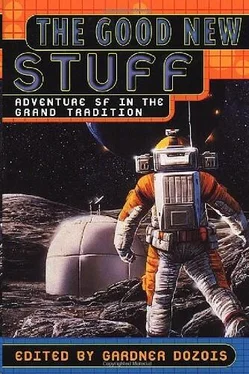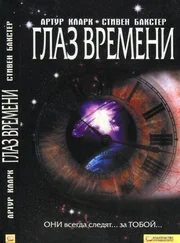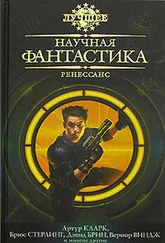Стивен Бакстер - The Good New Stuff
Здесь есть возможность читать онлайн «Стивен Бакстер - The Good New Stuff» весь текст электронной книги совершенно бесплатно (целиком полную версию без сокращений). В некоторых случаях можно слушать аудио, скачать через торрент в формате fb2 и присутствует краткое содержание. Год выпуска: 2002, ISBN: 2002, Издательство: St. Martin's Griffin, Жанр: Фантастика и фэнтези, на английском языке. Описание произведения, (предисловие) а так же отзывы посетителей доступны на портале библиотеки ЛибКат.
- Название:The Good New Stuff
- Автор:
- Издательство:St. Martin's Griffin
- Жанр:
- Год:2002
- ISBN:0-312-26456-9
- Рейтинг книги:3 / 5. Голосов: 1
-
Избранное:Добавить в избранное
- Отзывы:
-
Ваша оценка:
- 60
- 1
- 2
- 3
- 4
- 5
The Good New Stuff: краткое содержание, описание и аннотация
Предлагаем к чтению аннотацию, описание, краткое содержание или предисловие (зависит от того, что написал сам автор книги «The Good New Stuff»). Если вы не нашли необходимую информацию о книге — напишите в комментариях, мы постараемся отыскать её.
The Good New Stuff — читать онлайн бесплатно полную книгу (весь текст) целиком
Ниже представлен текст книги, разбитый по страницам. Система сохранения места последней прочитанной страницы, позволяет с удобством читать онлайн бесплатно книгу «The Good New Stuff», без необходимости каждый раз заново искать на чём Вы остановились. Поставьте закладку, и сможете в любой момент перейти на страницу, на которой закончили чтение.
Интервал:
Закладка:
"It could have been here for a long time, then."
"Yeah. We'll know better once Wai collects some samples from the tower."
There were five of the rectangles, arranged in parallel, one and a half meters long and one meter wide. The shell material below the shorter edge of each one had a set of ten grooves leading away down the curve.
"They looks like ladders to me," Antonio datavised. "Would that mean these are airlocks?"
"It can't be that easy," Schutz replied.
"Why not?" Marcus datavised. "A ship this size is bound to have more than one airlock."
"Yeah, but five together?"
"Multiple redundancy."
"With technology this good?"
"That's human hubris. The ship still blew up, didn't it?"
Wai locked the MSV's attitude 50 meters above the shell section. "The micropulse radar is bouncing right back at me," she informed them. "I can't tell what's below the shell, it's a perfect electromagnetic reflector. We're going to have communication difficulties once you're inside."
Marcus disengaged his boots from the grid and fired his pack's gas jets. The shell was as slippery as ice; neither stikpads nor magnetic soles would hold them to it.
"Definitely enhanced-valency bonds," Schutz datavised. He was floating parallel to the surface, holding a sensor block against it. "It's a much stronger field than Lady Mac 's. The shell composition is a real mix; the resonance scan is picking up titanium, silicon, boron, nickel, silver, and a whole load of polymers."
"Silver's weird," Marcus commented. "But if there's nickel in it our magnetic soles should've worked." He maneuvered himself over one of the rectangles. It was recessed about five centimeters, though it blended seamlessly into the main shell. His sensor collar couldn't detect any seal lining. Half way along one side were two circular dimples, ten centimeters across. Logically, if the rectangle was an airlock, then these should be the controls. Human back-ups were kept simple. This shouldn't be any different.
Marcus stuck his fingers in one. It turned bright blue.
"Power surge," Schutz datavised. "The block's picking up several high-voltage circuits activating under the shell. What did you do, Marcus?"
"Tried to open one."
The rectangle dilated smoothly, material flowing back to the edges. Brilliant white light flooded out.
"Clever," Schutz datavised.
"No more than our programmable silicon," Antonio retorted.
"We don't use programmable silicon for external applications."
"It settles one thing," Marcus datavised. "They weren't Kiint, not with an airlock this size."
"Quite. What now?"
"We try to establish control over the cycling mechanism. I'll go in and see if I can operate the hatch from inside. If it doesn't open after ten minutes, try the dimple again. If that doesn't work, cut through it with the MSV's fission blade."
The chamber inside was thankfully bigger than the hatch: a pentagonal tube two meters wide and 15 long. Four of the walls shone brightly, while the fifth was a strip of dark-maroon composite. He drifted in, then flipped himself over so he was facing the hatch, floating in the center of the chamber. There were four dimples just beside the hatch. "First one," he datavised. Nothing happened when he put his fingers in. "Second." It turned blue. The hatch flowed shut.
Marcus crashed down onto the strip of dark composite, landing on his left shoulder. The force of the impact was almost enough to jar the respirator tube out of his mouth. He grunted in shock. Neural nanonics blocked the burst of pain from his bruised shoulder.
Jesus! They've got artificial gravity.
He was flat on his back, the exoskeleton and maneuvering pack weighing far too much. Whatever planet the xenocs came from, it had a gravity field about one and a half times that of Earth. He released the catches down the side of his exoskeleton, and wriggled his way out. Standing was an effort, but he was used to higher gees on Lady Mac; admittedly not for prolonged periods, though.
He stuck his fingers in the first dimple. The gravity faded fast, and the hatch flowed apart.
"We just became billionaires," he datavised.
The third dimple pressurized the airlock chamber; while the fourth depressurized it.
The xenoc atmosphere was mostly a nitrogen-oxygen blend, with one per cent argon and six per cent carbon dioxide. The humidity was appalling, pressure was lower than standard, and the temperature was 42 degrees Celsius.
"We'd have to keep our SII suits on anyway, because of the heat," Marcus datavised. "But the carbon dioxide would kill us. And we'll have to go through biological decontamination when we go back to Lady Mac."
The four of them stood together at the far end of the airlock chamber, their exoskeleton armor lying on the floor behind them. Marcus had told Wai and the rest of the crew their first foray would be an hour.
"Are you proposing we go in without a weapon?" Jorge asked.
Marcus focused his collar sensors on the man who alleged he was a hardware technician. "That's carrying paranoia too far. No, we do not engage in first contact either deploying or displaying weapons of any kind. That's the law, and the Assembly regulations are very specific about it. In any case, don't you think that if there are any xenocs left after all this time they're going to be glad to see someone? Especially a space-faring species."
"That is, I'm afraid, a rather naive attitude, Captain. You keep saying how advanced this starship is, and yet it suffered catastrophic damage. Frankly, an unbelievable amount of damage for an accident. Isn't it more likely this ship was engaged in some kind of battle?"
Which was a background worry Marcus had suffered right from the start. That this starship could ever fail was unnerving. But like physical constants, Murphy's Law would be the same the universe over. He'd entered the airlock because intuition told him the wreck was safe for him personally. Somehow he doubted a man like Jorge would be convinced by that argument.
"If it's a warship, then it will be rigged to alert any surviving crew or flight computer of our arrival. Had they wanted to annihilate us, they would have done so by now.
Lady Mac is a superb ship, but hardly in this class. So if they're waiting for us on the other side of this airlock, I don't think any weapon you or I can carry is going to make the slightest difference."
"Very well, proceed."
Marcus postponed the answer which came straight to mind, and put his fingers in one of the two dimples by the inner hatchway. It turned blue.
The xenoc ship wasn't disappointing, exactly, but Marcus couldn't help a growing sense of anticlimax. The artificial gravity was a fabulous piece of equipment, the atmosphere strange, the layout exotic. Yet for all that, it was just a ship; built from the universal rules of logical engineering. Had the xenocs themselves been there, it would have been so different. A whole new species with its history and culture. But they'd gone, so he was an archaeologist rather than an explorer.
They surveyed the first deck, which was made up from large compartments and broad hallways. The interior was made out of a pale-jade composite, slightly ruffled to a snake-skin texture. Surfaces always curved together, there were no real corners. Every ceiling emitted the same intense white glare, which their collar sensors compensated for. Arching doorways were all open, though they could still dilate if you used the dimples. The only oddity were 50-centimeter hemispherical blisters on the floor and walls, scattered completely at random.
There was an ongoing argument about the shape of the xenocs. They were undoubtedly shorter than humans, and they probably had legs, because there were spiral stair-wells, although the steps were very broad, difficult for bipeds. Lounges had long tables with large, rounded stool-chairs inset with four deep ridges.
Читать дальшеИнтервал:
Закладка:
Похожие книги на «The Good New Stuff»
Представляем Вашему вниманию похожие книги на «The Good New Stuff» списком для выбора. Мы отобрали схожую по названию и смыслу литературу в надежде предоставить читателям больше вариантов отыскать новые, интересные, ещё непрочитанные произведения.
Обсуждение, отзывы о книге «The Good New Stuff» и просто собственные мнения читателей. Оставьте ваши комментарии, напишите, что Вы думаете о произведении, его смысле или главных героях. Укажите что конкретно понравилось, а что нет, и почему Вы так считаете.











